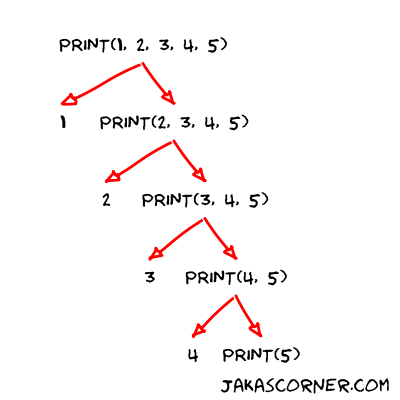Variadic number of arguments
The constructor of the std::thread is able to accept
different number of arguments. It accepts a function and additionally
all the arguments for this function. If the function f
has n arguments, then the constructor looks like
std::thread thread(f, arg1, arg2, ..., argn);If we would like to write concurrent code, we need to know how to handle functions (constructors) with variadic number of arguments. We need to know how to write such functions and we also need to know how to pass the arguments around. Let’s see how this is done.
Functions with variadic number of arguments
We would like to write a function which prints all of its arguments. The function should be able to handle any number of arguments. With the C++11 standard, this is not so hard to do.
template <typename T>
void print(T value)
{
std::cout << value << " ";
}
template <typename T, typename... Args>
void print(T first, Args... args)
{
std::cout << first << " ";
print(args...);
}First function is simple. It receives a value of arbitrary type and then prints the value.
Second function is more interesting. It receives two arguments
first and args. The
first argument of type T represents the
first argument of the function. The args argument of the type
Args... represents all of the other arguments. The function
prints the first argument and calls the function print with
all the other arguments.
The main function contains some examples.
int main()
{
print(1);
std::cout << std::endl;
print(1, 2, 3, 4, 5);
std::cout << std::endl;
print("one", 2, "three", 4, "five");
std::cout << std::endl;
return 0;
}Running the program gives us the following output.
$ ./variadicTemplates
1
1 2 3 4 5
one 2 three 4 five Let’s examine the main() function.
The print(1) calls the print(T value). It
prints 1 and then returns.
The print(1, 2, 3, 4, 5) calls the print(T first,
Args... arg) function. The first then equals to
1 and the args... equals to 2, 3,
4, 5. The function prints 1 and calls
print(2, 3, 4, 5). The procedure continues until
print(5) is called. After this call the
print(1, 2, 3, 4, 5) returns and the main function proceeds
with the next line.
You can visualize the print(1, 2, 3, 4, 5) like this:

The print("one", 2, "three", 4, "five") demonstrates that we
can also pass arguments of different types.
Programming the functions with variadic number of arguments feels like
programming the recursive functions. Basically this is what we did: If the
number of arguments is equal to one, we print the argument. If the number of
arguments is greater than 1, we print the first argument and invoke
print with the other arguments.
Technically, it is not a recursion, because every time different compiler generated function is called. But conceptually, I would call it a recursion.
The code does not look very clean. We recognize some repeating patterns. The
main function calls print and then prints a new line. Our
objective is to write such function which will print arbitrary number of
arguments followed by a new line.
Forwarding variadic number of arguments
Let’s write a function println which will forward the
arguments to print and then it will additionally print a new
line. The println should also accept variadic number of
arguments.
template <typename... Args>
void println(Args&&... args)
{
print(std::forward<Args>(args)..).;
std::cout << std::endl;
}The Args&&... and std::forward<Args>... are
necessary for perfect forwarding of the arguments. Roughly speaking, the code
ensures the following behavior: If the arguments support the move semantics they
will be moved. If the arguments does not support the move semantics they will be
passed by reference. For additional details about forwarding and move semantics
I recommend the series of
articles by
Thomas Becker.
The main function now simplifies to
int main()
{
println(1);
println(1, 2, 3, 4, 5);
println("one", 2, "three", 4, "five");
return 0;
}and it produces the same output as before.
Summary
We learned how to handle a variadic number of arguments. This is specially important in concurrent programming, because we might want to write a code which could handle arbitrary number of arguments.
Links:
- Source code
- Eli Bendersky wrote a nice article about handling arbitrary number of arguments. He also covers variadic data structures.
- Thomas Becker’s series of articles in depth covers moving semantics and forwarding.